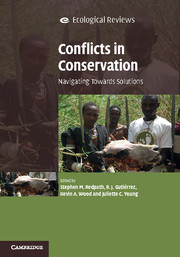Book contents
- Frontmatter
- Dedication
- Contents
- List of contributors
- Foreword by Georgina Mace
- Acknowledgements
- Part I Introduction to conservation and conflict
- PART II Contrasting disciplinary approaches to the study of conflict in conservation
- Part III Approaches to managing conflicts
- 14 Modelling conservation conflicts
- 15 Defining scales for managing biodiversity and natural resources in the face of conflicts
- 16 Mediation and conservation conflicts: from top-down to bottom-up
- 17 Designing and facilitating consensus-building – keys to success
- 18 Conservation conflict transformation: the missing link in conservation
- 19 Legislated collaboration in a conservation conflict: a case study of the Quincy Library Group in California, USA
- 20 Finding a way out of conservation conflicts
- Index
- Plate Section
- References
14 - Modelling conservation conflicts
from Part III - Approaches to managing conflicts
Published online by Cambridge University Press: 05 May 2015
- Frontmatter
- Dedication
- Contents
- List of contributors
- Foreword by Georgina Mace
- Acknowledgements
- Part I Introduction to conservation and conflict
- PART II Contrasting disciplinary approaches to the study of conflict in conservation
- Part III Approaches to managing conflicts
- 14 Modelling conservation conflicts
- 15 Defining scales for managing biodiversity and natural resources in the face of conflicts
- 16 Mediation and conservation conflicts: from top-down to bottom-up
- 17 Designing and facilitating consensus-building – keys to success
- 18 Conservation conflict transformation: the missing link in conservation
- 19 Legislated collaboration in a conservation conflict: a case study of the Quincy Library Group in California, USA
- 20 Finding a way out of conservation conflicts
- Index
- Plate Section
- References
Summary
Modelling enables theory and empirical evidence to be brought together to build representations of how real-world systems work and how they are likely to respond to external influences. Models can take many forms, such as simple verbal or written descriptions, flow diagrams, sets of mathematical equations or computer programs. Usually the process begins with the development of a verbal or written description of a real-world system (i.e. a ‘conceptual model’), which subsequently can be translated into a mathematical or computational format (i.e. an ‘implemented model’). This implemented model can then be given appropriate inputs such that outputs, predicting the dynamics of the system of interest, are generated (Edmonds and Hales, 2003; Wilensky and Rand, 2007; Fig. 14.1). The outputs can then be compared to understanding or empirical data related to the behaviour of a natural system and this comparison can result in modification of the conceptual model. This iterative process can make a major contribution to our understanding of how systems work and what may be the crucial drivers of a system (Edmonds, 2000; Fig. 14.1).
It has been argued that the most important goal of modelling is to understand general mechanisms, not to generate specific predictions using models (Grimm, 1999). However, where sufficient, empirically verified, knowledge and understanding of a system exists, models can provide an excellent means for testing how a complex system may respond to different drivers for a natural resource system, and assess the likely responses of a system to alternative possible future management (Frederiksen et al., 2001; Bunnefeld et al., 2011). Importantly, even in cases where knowledge of a system is too limited for modelling to provide robust quantitative predictions, models can still be developed that yield useful qualitative predictions of expected trends and system dynamics (such as population cycles or the risk of extinction), particularly about influential mechanisms of the system.
Models can help us understand where and why ecological conflicts occur. They enable us to identify the main drivers of conflict by simplifying the system to key components that still replicate patterns in the real conflict system.
- Type
- Chapter
- Information
- Conflicts in ConservationNavigating Towards Solutions, pp. 195 - 211Publisher: Cambridge University PressPrint publication year: 2015
References
- 2
- Cited by



